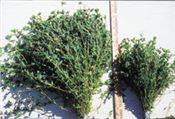|
Pasture Legumes – Something For Nothing
KEITH CARMICHAEL
LOWRY CITY, MO.
Adding Protein and Nitrogen
We have all been cautioned to be skeptical of the idea of getting ‘something for nothing’. “If it’s too good to be true, it probably is”. There are times when cattlemen can get something for nothing – one is when they use heterosis or cross-breeding to produce more pounds of beef, and the other is when they use legumes – clovers, alfalfa and also annual lespedeza to add protein and nitrogen to pasture to produce more pounds of beef. With today’s commercial N prices… it’s time to be thinking about next year’s grazing program and pasture fertility.
Most are quite familiar with using several types of clover and even alfalfa in the pasture, but one of the most over-looked legumes has been annual lespedeza – especially Lespedeza striata. The taller, more productive Legend lespedeza in this category is causing producers to take another look at this niche summer forage.
Legumes pay their own way
In addition to being an essential protein source in the pasture mix; legumes like clovers and annual lespedeza add diversity and produce their own nitrogen, which eventually becomes available to grasses as well. At today’s nitrogen prices, the cost of seed and establishment is easily offset by an increase in animal performance or the added nitrogen produced – one or the other is FREE –take your pick. Over-seeding pastures and hay fields with legumes is basic, common sense management, but which is best for your operation? The answer is probably… ‘All of the above’. No single legume can do it all. Soil fertility, pH, texture, and drainage all help determine which legume is best for a particular soil-type.
Annual Lespedeza
Annual Lespedeza, which is again in the spotlight, is amazingly tolerant to drought conditions and low pH soils. It is also one of the few legumes that do not cause bloat. Adding annual lespedeza with other legumes into cool-season grass pastures can mean extra forage and extra pounds as these grasses often leave a significant forage gap in summer months. Milk production, weaning-weights and reproductive efficiency are all closely tied to the animal nutrition during this period.
Renewed Interest in Lespedeza
The renewed interest in annual lespedeza has a lot to do with the continued success of Legend lespedeza, an annual-striate lespedeza that is nearing its 20th year of commercial production. Legend continues to dominate forage tests throughout the region. It has been grown effectively for both pasture and hay all over the lower Midwest and throughout the South, from northern Missouri and southeast Kansas to Georgia. A number of producers have also found the Legend lespedeza to work well with warm-season grasses, with adequate management, in both grazing and hay production in areas in Mississippi, Alabama and Florida.
Compared to other types, the taller Legend exhibits a greater leaf to stem ratio. In some cases the advantage in dry-matter yield has proved to be 2 to 1. Producers who have grown a variety of lespedezas over the years characterize Legend as a “very leafy lespedeza that grows taller and reseeds itself very well”. In fact, one of the problems seed producers have is getting the Legend lespedeza plant that is “all leaves” to drop its leaves and dry down – even after a light frost.
Annual lespedezas should not to be confused with its perennial cousin – Sericea which is serious weed problem in many areas.
Spring, Summer and Fall
When planting the newer, safer types of fescue, or other cool-season grasses, lespedeza is the one legume that can be recommended as a companion the first season because it does not compete aggressively with the new grass early in the spring.
The effects of endophyte toxicity in most fescue pastures during the summer are hard to measure, but well documented. This fungus affects all of animal performance – especially reproduction. Annual lespedeza in pastures can ‘dilute’ and significantly reduce its effect. With annual lespedeza, it’s all about ‘timing’! Providing a ‘home-grown protein’ boost is good, but providing it WHEN YOU NEED IT MOST is even better. Long appreciated for its drought tolerance and summer growth, this non-bloating legume is again proving its worth in grazing systems and as a hay crop.
Fall stockpiling of fescue pasture is very important in many operations and the management required to stockpile this forage fits very well in allowing annual lespedeza to re-seed itself. ∆
KEITH CARMICHAEL: Editor/Midwest Cattleman, Agricultural Educator & Cattleman, Owner/Cutting-Edge USA, LLC

Legend lespedeza, right, next to the once poplar Marion variety, is nearing its 20th year of commercial production.
|
|